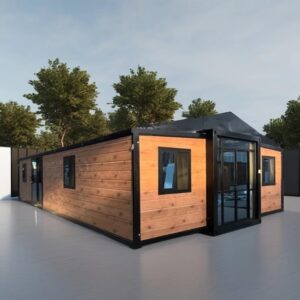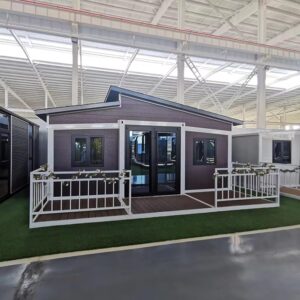Description
- **Perfect Family House Features** _ Expandable design with enough space for a family – External Dimensions for ground floor: L 360 W 240 H 112 Inches. Top floor_ L 228 W 108 H 86 inchesThe thoughtfully designed layout with bedrooms – 1 living room – 1 fully equipped kitchen area – 1 separate wet and dry bathroom.
- **Basic Living Features**_ More living area than standard foldable houses Standard large windows for ample natural lighting – All doors with locks – 1 smaller window for shower room – 1 glass entry door to the bathroom. Fully equipped bathroom features_ Cabinets – Water heater – Toilet – Sink – Mirror – Private shower area. Kitchen with cabinets-taps-hot and cold pipelines-sink.
- ** Structure**_ Double glazed PVC sliding window and security doors made of broken bridge aluminum. Prefabricated US standard electrical and plumbing systems – Exterior walls and roof insulated with flame-retardant foam panels – Main structure made of strong steel frame composed of sturdy square steel tubes – Optimal natural lighting throughout the interior- Excellent thermal insulation and soundproofing.
- **Safety Features**_- Wind, Earthquake, Fire and Waterproof. Typhoon resistant. Fire-rated Class A – Wind-resistant up to level 11 – Seismic-resistant up to level 9. ** Customizable**_Color can be customized. The exterior can also be customized. Keeping your needs in mind we offer a list of customizable options: -1 bedroom,1 living room, 1 bathroom -2 bedrooms,1 living room,1 bathroom -3 bedrooms, 1 living room,1 bathroom -4 bedrooms,1 bathroom.
- ** Installation**_ Save more labor and material costs. Suitable for various locations, including urban and remote areas Perfect for temporary or long-term family residence. **Note**_ Regularly remove snow accumulation on the roof during heavy snowfall – Snow height should not exceed 6.6ft





Kayla –
Setting up the **S.E.Q Double Story Tiny Prefab Container House** is generally straightforward, but as with any prefab home, there can be challenges along the way. Here’s a look at some of the common setup issues you might face and how to fix or avoid them:
### 1. **Foundation Problems:**
– **Problem**: One of the most common issues is not having the right foundation in place. Since this is a heavy container home, it requires a solid, level foundation to avoid structural damage over time. If the foundation isn’t properly prepared, you might face problems like the container shifting or water pooling underneath.
– **Fix**: Ensure that you have a solid foundation, such as a **concrete slab, gravel base, or raised steel beams**, depending on your terrain. Always consult a local contractor or expert to assess your land before installation. A well-prepared foundation will keep the house stable and prevent drainage issues.
### 2. **Local Building Codes and Zoning Issues:**
– **Problem**: Depending on where you’re planning to set up the container home, you might encounter problems with **local zoning laws** or **building permits**. Some areas have strict regulations regarding the placement of container homes, especially for permanent living.
– **Fix**: **Research local regulations** before purchasing the home. Reach out to your municipality or county building department to understand the permits you need. You may also need to hire a professional to ensure that the home complies with electrical, plumbing, and safety standards in your area. Sometimes, these homes are classified as temporary structures, which might simplify the permit process.
### 3. **Transport and Delivery:**
– **Problem**: Due to the size and weight of the double-story container, delivering and positioning the home on-site can be tricky. Narrow roads, overhead obstacles, or uneven ground might complicate the transport process.
– **Fix**: Ensure that your site is easily accessible for delivery trucks and cranes. Clear the access route of any obstacles like low-hanging branches or power lines. If you’re placing the container on uneven ground, you may need to bring in leveling equipment or hire professionals to adjust the terrain.
### 4. **Utility Connections:**
– **Problem**: Connecting the prefab home to essential utilities such as water, electricity, and sewage can be difficult, especially in remote locations. If your site is off the grid, this becomes even more complicated.
– **Fix**: Before installation, work with local contractors to ensure you have the **necessary hookups** for water, electricity, and sewage. If you’re off-grid, consider **solar panels** for electricity and **rainwater collection systems** or **composting toilets** for water and waste management. It’s a good idea to have a certified electrician and plumber on hand for the setup.
### 5. **Insulation and Climate Control:**
– **Problem**: While container homes generally come insulated, poor insulation can lead to extreme temperatures inside the home. In hot climates, the metal walls of the container can absorb and radiate heat, while in cold climates, the house can become chilly if not properly insulated.
– **Fix**: Make sure the home has **adequate insulation**, especially in the walls, ceiling, and floor. You can also add **insulated panels** or **spray foam insulation** to improve heat retention or cooling efficiency. Additionally, consider installing **air conditioning** or **heating systems** that are appropriate for your climate.
### 6. **Waterproofing and Drainage:**
– **Problem**: Because the container house has a metal frame, it’s vulnerable to **water damage** or rust over time if it’s not properly waterproofed. Poor drainage around the foundation can also cause water to pool, leading to long-term damage.
– **Fix**: Apply **waterproofing treatments** to the exterior, especially around joints and seams, to prevent rust and water infiltration. It’s also essential to ensure good drainage around the house. Install a drainage system or grade the land around the home to divert water away from the foundation.
### 7. **Assembly and Finishing Issues:**
– **Problem**: If the prefab home arrives in parts or needs additional assembly, there might be issues with improperly fitted joints, misaligned doors, or incomplete interior finishes.
– **Fix**: When receiving a container home, it’s crucial to do a thorough inspection before and after assembly. If anything seems off—such as doors not fitting properly or gaps in the structure—work with a professional to address these issues. Having a contractor oversee the final assembly can help catch these problems early.
### 8. **Ventilation Concerns:**
– **Problem**: Due to the steel structure, container homes can sometimes have poor ventilation, leading to condensation build-up, especially in humid environments.
– **Fix**: Install **ventilation systems** or **airflow vents** to allow fresh air to circulate. You might also want to invest in a **dehumidifier** if you’re in a humid area to prevent moisture build-up, which can lead to mold and mildew.
### Final Thoughts:
While the **S.E.Q Double Story Tiny Prefab Container House** is a fantastic option for those seeking a modern, compact living space, the setup process requires careful planning to avoid these common issues. By preparing the foundation, understanding local regulations, and taking precautions with utilities and insulation, you can ensure a smooth and successful installation of your container home.